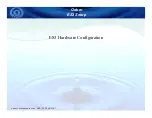
15
5.
Link
controls the relationship between the left (upper) channel and the right (lower)
channel.
States
Left/Right, Linked, Lateral/Vertical
Left/Right
The compressor acts as two completely separate compressors, with the option to separately
adjust all controls per channel. This mode can significantly change the stereo image of a
stereo signal.
Link
Both channels are linked to one another. Upper channel controls both channels, while lower
channel settings are grayed out. The compression detector will calculate the maximum level
of the two channels combined, and compress both channels according to the maximum
level. This mode better preserves the stereo image of a signal.
Lateral/Vertical
Feeds the stereo signal through a sum/difference matrix which splits the stereo signal into
sum (fed to the upper/left channel) and difference (fed to the lower/right channel). The
input level is set after the matrix, so the relationship between the sum and the difference
channels can be controlled. At the compressor output, the signal passes through a second
matrix which turns it back into a Left/Right stereo signal. (Output gain occurs before the
second matrix).
6.
Mains
control analog characteristics caused by noise floor and hum, based on the power
supplies of the original units.
Range: Off, 50Hz, 60Hz
7.
Input Gain/Trim
controls the volume of the signal entering the audio compression path.
Input Trim
Controls the level of the analog input
Range: -6 to +5 dB
Resolution: 1 dB steps
Input Gain
Controls the volume of the signal entering the digital audio compression path.
Range: -20 to 0 dB
Resolution: 1dB steps
Note: -14dB is unity gain (input = output)










































